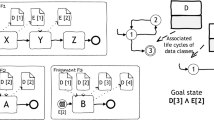Abstract
Modeling business processes can be difficult, especially if they are flexible and the models consist of many interconnected parts. This is the case for hybrid process modeling approaches, such as fragment-based case management. Also, erroneous and low-quality models have adverse effects on the whole BPM lifecycle. To support creating fragment-based case models, we provide a set of guidelines and integrate them into a modeling tool called fcm-js. Our evaluation shows that fcm-js improves the quality of the process model as well as the user experience during modeling.
Access this chapter
Tax calculation will be finalised at checkout
Purchases are for personal use only
Similar content being viewed by others
Notes
- 1.
The guidelines are published on GitHub: https://github.com/bptlab/fCM-design-support/wiki.
- 2.
- 3.
We use the example use case of criminal justice to provide examples for the guidelines: https://github.com/bptlab/fCM-design-support/wiki/Example-Use-Case---Criminal-Justice.
- 4.
Repository with source code and screencast at https://github.com/bptlab/fCM-design-support.
- 5.
- 6.
- 7.
References
Avila, D.T., dos Santos, R.I., Mendling, J., Thom, L.H.: A systematic literature review of process modeling guidelines and their empirical support. Bus. Process. Manage. J. 27(1), 1–23 (2021). https://doi.org/10.1108/BPMJ-10-2019-0407
Corradini, F., et al.: A guidelines framework for understandable BPMN models. Data Knowl. Eng. 113, 129–154 (2018). https://doi.org/10.1016/j.datak.2017.11.003
Dumas, M., Rosa, M.L., Mendling, J., Reijers, H.A.: Fundamentals of Business Process Management, 2nd edn. Springer, Cham (2018). https://doi.org/10.1007/978-3-662-56509-4
Estañol, M., Sancho, M.-R., Teniente, E.: Verification and validation of UML artifact-centric business process models. In: Zdravkovic, J., Kirikova, M., Johannesson, P. (eds.) CAiSE 2015. LNCS, vol. 9097, pp. 434–449. Springer, Cham (2015). https://doi.org/10.1007/978-3-319-19069-3_27
Green, T.R.G., Petre, M.: Usability analysis of visual programming environments: a ‘cognitive dimensions’ framework. J. Vis. Lang. Comput. 7(2), 131–174 (1996). https://doi.org/10.1006/jvlc.1996.0009
Haarmann, S., Montali, M., Weske, M.: Refining case models using cardinality constraints. In: La Rosa, M., Sadiq, S., Teniente, E. (eds.) CAiSE 2021. LNCS, vol. 12751, pp. 296–310. Springer, Cham (2021). https://doi.org/10.1007/978-3-030-79382-1_18
Haarmann, S., Weske, M.: Correlating data objects in fragment-based case management. In: Abramowicz, W., Klein, G. (eds.) BIS 2020. LNBIP, vol. 389, pp. 197–209. Springer, Cham (2020). https://doi.org/10.1007/978-3-030-53337-3_15
Hasic, F., Smedt, J.D., Vanthienen, J.: Augmenting processes with decision intelligence: principles for integrated modelling. Decis. Support Syst. 107, 1–12 (2018). https://doi.org/10.1016/j.dss.2017.12.008
van Hee, K., Serebrenik, A., Sidorova, N., Voorhoeve, M., van der Werf, J.M.: Modelling with history-dependent petri nets. In: Alonso, G., Dadam, P., Rosemann, M. (eds.) BPM 2007. LNCS, vol. 4714, pp. 320–327. Springer, Heidelberg (2007). https://doi.org/10.1007/978-3-540-75183-0_23
Hewelt, M., Pufahl, L., Mandal, S., Wolff, F., Weske, M.: Toward a methodology for case modeling. Softw. Syst. Model. 19(6), 1367–1393 (2019). https://doi.org/10.1007/s10270-019-00766-5
Hewelt, M., Weske, M.: A hybrid approach for flexible case modeling and execution. In: La Rosa, M., Loos, P., Pastor, O. (eds.) BPM 2016. LNBIP, vol. 260, pp. 38–54. Springer, Cham (2016). https://doi.org/10.1007/978-3-319-45468-9_3
Kunze, M., Weske, M.: Signavio-oryx academic initiative. In: Proceedings of the Business Process Management 2010 Demonstration Track, Hoboken, NJ, USA, 14–16 September 2010. CEUR Workshop Proceedings, vol. 615. CEUR-WS.org (2010). http://ceur-ws.org/Vol-615/paper6.pdf
Leopold, H., Mendling, J., Günther, O.: Learning from quality issues of BPMN models from industry. EMISA Forum 36(2), 120–123 (2016)
López, H.A., Debois, S., Hildebrandt, T.T., Marquard, M.: The process highlighter: from texts to declarative processes and back. In: Proceedings of the Dissertation Award, Demonstration, and Industrial Track at BPM 2018, Sydney, Australia, 9–14 September 2018, pp. 66–70 (2018). http://ceur-ws.org/Vol-2196/BPM_2018_paper_14.pdf
Mendling, J., Reijers, H.A., van der Aalst, W.M.P.: Seven process modeling guidelines (7PMG). Inf. Softw. Technol. 52(2), 127–136 (2010). https://doi.org/10.1016/j.infsof.2009.08.004
Moreno-Montes de Oca, I., Snoeck, M.: Pragmatic guidelines for business process modeling (2014). Available at SSRN 2592983
OMG: Business process model and notation BPMN v. 2.0 (2011)
Snoeck, M.: Enterprise Information Systems Engineering - The MERODE Approach. The Enterprise Engineering Series, Springer, Cham (2014). https://doi.org/10.1007/978-3-319-10145-3
Steinau, S., Andrews, K., Reichert, M.: A modeling tool for PHILharmonicFlows objects and lifecycle processes. In: Proceedings of the BPM Demo Track and BPM Dissertation Award 2017, Barcelona, Spain, 13 September 2017. CEUR Workshop Proceedings, vol. 1920. CEUR-WS.org (2017). http://ceur-ws.org/Vol-1920/BPM_2017_paper_196.pdf
Weske, M.: Business Process Management - Concepts, Languages, Architectures, 3rd edn. Springer, Cham (2019). https://doi.org/10.1007/978-3-662-59432-2
Author information
Authors and Affiliations
Corresponding author
Editor information
Editors and Affiliations
Rights and permissions
Copyright information
© 2023 Springer Nature Switzerland AG
About this paper
Cite this paper
Andree, K. et al. (2023). Design-Time Support for Fragment-Based Case Management. In: Cabanillas, C., Garmann-Johnsen, N.F., Koschmider, A. (eds) Business Process Management Workshops. BPM 2022. Lecture Notes in Business Information Processing, vol 460. Springer, Cham. https://doi.org/10.1007/978-3-031-25383-6_17
Download citation
DOI: https://doi.org/10.1007/978-3-031-25383-6_17
Published:
Publisher Name: Springer, Cham
Print ISBN: 978-3-031-25382-9
Online ISBN: 978-3-031-25383-6
eBook Packages: Computer ScienceComputer Science (R0)




